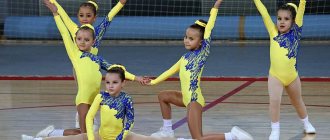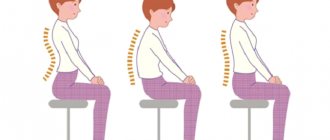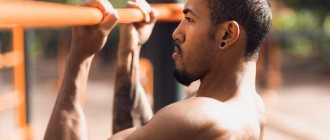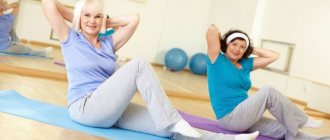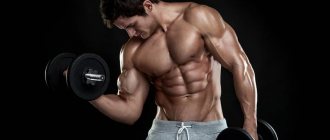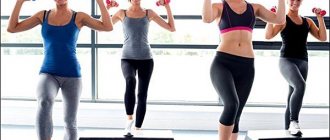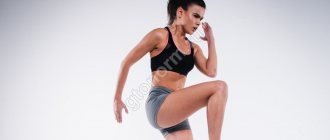Parents are always puzzled by the well-being of their child and try to give him the best so that the child grows up healthy and self-confident.
In the modern world, more and more attention is paid to children's fitness, but many confuse this concept with sections or ordinary physical education. This is fundamentally the wrong approach; today we will look in detail at what children’s fitness is and why your child needs it.
What is children's fitness?
First, you need to understand that this is a special exercise program that has nothing to do with physical education lessons and physiological inclinations are not important here, as when visiting sports sections.
Children's fitness clubs have already been opened in every major city; sometimes they are combined with a gym where parents train, but classes for children are conducted by a trainer specializing in working with children.
This is a very important point, because working with children requires a special approach:
- Psychological (somewhat includes the educational process);
- Physiological characteristics of a growing organism;
- Anatomy.
Children's fitness classes are conducted on a voluntary basis and are not divided according to the child's abilities.
Speaking about fitness for children, we can characterize it as sports activities that include several key elements of dance, gymnastics, yoga, aerobics and even sometimes martial arts.
Organization of a physical education program for preschoolers
The program clearly regulates what training should be, when and where to conduct it, and for what age audience. Each workout should consist of 3 stages: warm-up, main and final part. Warm-up is the most important stage, since without it you cannot do any physical activity, otherwise injuries may occur.
The teacher gives simple movements that prepare muscles, joints and other organs for more complex elements. The progress of the main part of the training depends on the direction of fitness that is given in a particular period.
In the last part of the lesson, teachers mainly use a game form - this relieves tension, children restore their breathing, their heart rate normalizes, and the training ends on a positive note, after which the students want to attend classes again.
The program for preschoolers is focused on working with children, regardless of whether they have special physical abilities, the only condition for classes is the absence of medical contraindications. Therefore, children from 3 years old can attend training.
The teacher outlines the “children’s fitness” program, and then conducts classes according to it, dividing children into age groups, because the training duration is different for each age. So, for children 3-4 years old its duration should not be more than 20-25 minutes, for children 4-6 years old the training can be increased to 30 minutes, and for children 6-7 years old – 35 minutes. Classes are held 2-3 times a week.
To organize the activities of pupils, taking into account the individual characteristics of each age period, the group size should not exceed 10-15 people. This number of children is optimal for the individual development of each child.
Children's fitness (the program for preschoolers includes, in most cases, general strengthening exercises) and for the full implementation of this program, special equipment is required.
Namely :
- gymnastic benches;
- mats;
- exercise bikes;
- Treadmills;
- step platforms;
- fitballs;
- dumbbells;
- gymnastic sticks;
- jump ropes;
- hoops;
- balls of different sizes;
- gymnastic mats.
The teacher conducts classes in a well-lit, dry, ventilated and clean gym; the floor covering should not be slippery, have uneven surfaces or cracks.
What exercises, complexes, games to music are recommended by child development specialists?
The teacher can give various general developmental tasks, types of walking, running, jumping, skipping, including elements from dances (ropes, pick-ups) and movements (polka, variable step, step with stomp).
Types of fitness for the little ones
Classes are held not only in special clubs, but also often on the basis of dance schools or sports sections. In order to interest your child in visiting the center, you can invite him to independently choose the direction of training that suits him best.
Children's fitness programs are compiled depending on the type:
The most popular is children's fitness in the pool; there are even special “infant swimming” programs;
Children's yoga is ideal for a hyperactive child;
If your child has flat feet, then ask the children's fitness center about the BABY TOP program;
STEP BY STEP has a good effect on the development of motor skills, and helps to activate thought processes by working with the tops and fingers, where many nerve endings are concentrated.
For parents who want to combine children's fitness with mental work, in order to captivate the child as much as possible, the “Logo-aerobics” type is suitable; when performing exercises, the emphasis is on speech development. This is a rather complex subspecies, and before you send your child to such training, watch a video of children's fitness logo aerobics on the Internet.
At what age can you start children's fitness classes?
Due to the characteristics of a growing body, fitness aerobics classes for children have a number of age restrictions:
For children under 5 years of age, two visits lasting no more than 30 minutes are recommended;
The next age group is designed for children from 5 to 10 years old, there is a higher load. Three lessons per week of up to 40 minutes are allowed;
Children over 11 years old can do training for 40 minutes.
Water aerobics for children, as a rule, lasts up to 30 minutes, but the active time does not exceed 10.
In order to track your child's physical activity, you can purchase a children's fitness watch.
Benefits of classes
Children's aerobics, as stated, is designed both for adolescence (for example, for a 12-year-old schoolchild) and for smaller children. What advantages does children's aerobics have relative to other sports? Let's look at some of them:
- Develops and increases children's activity and cheerfulness.
- Helps develop the child's speech abilities.
- Increases immunity.
- Strengthens the bone structure of the child's body.
- Children's aerobics helps prevent the development of some childhood pathologies that threaten the child's body with a sedentary lifestyle.
- Complex exercises improve coordination of movements.
- Forms correct posture in children.
- Promotes the improvement of important functions in the body, and also improves the functioning of the musculoskeletal system.
- Improves the metabolic process in the body. Promotes weight loss.
- Charging for 10 years and above Increases endurance and strength.
- Reduces the likelihood of developing heart pathologies.
- Prevents the development of cancer cells.
- Promotes normal digestion.
- Prevents the appearance and development of flat feet.
- Improves joint function.
- Strengthens the respiratory system.
Originally posted 2018-01-09 08:51:37.
Benefits of Fitness for Children
Considering that fitness classes for a child are a specially designed program that takes into account the age and physiological development of the child, we can say that this is a unique training that your child needs not only for activity, but also for development at a certain stage.
The benefits include the fact that your child will communicate in a group of his peers, which will help establish communication ties in society. Since the classes are not graded and there is no allocation, as, for example, in sections, your child will feel confident.
In addition, sport instills discipline from childhood, which will make the child more focused and purposeful.
Another advantage of attending classes is that the programs include several areas at the same time, which will help you pay attention to the sports inclinations and disposition of your child in order to send him to professional sports in the future.
When answering the question of how much a subscription to children's fitness costs, you can reassure parents that the cost is not high, equal to about a month's visit to kindergarten.
Contraindications for children to engage in fitness.
Even chronic diseases cannot be classified as strict contraindications; in this case, you just need to choose the right program that will improve the child’s health and will not harm him.
But, here you need to consult a doctor and carefully choose a trainer who has already had experience working with children with a similar disease.
Due to the huge selection of different types of children's fitness, there are no completely clear restrictions on a complete ban on classes.
The difference between children's fitness and sports sections
It is important that, unlike professional sections, there is no exhausting physical activity, and all exercises are performed easily and do not have any evaluative connotation behind them.
Psychological influence during fitness is also completely excluded and all exercises are performed in the form of a game, without passing any mandatory standards based on the results of training. Another significant difference is the fact that fitness focuses on the development of the child in general, rather than focusing on a specific sport.
As a rule, children go to such classes without feeling forced.
A set of exercises for children's fitness physical education consultation
Complex No. 1
Stretching
1. Exercise “Oak” (5 s). I. p.: Wide stance, feet parallel, arms down along the body. 1-stretch your arms above your head, palms facing each other, do a half-squat, legs firmly resting on the floor, inhale; lower your arms, exhale, relax.
2. Exercise “Waffle” (5 s). I. p.: sitting on the buttocks, legs straightened in front of you. 1-stretch upward with straight arms, straighten your back, stretch your spine upward; 2-lean forward with your chest, press your forehead to your knees; 3-4- return to i. P.
3. Exercise “Airplane” (5 s). I. p.: sitting on your knees, arms along the body. 1- straighten your right (left) leg back, buttocks on the left (right) heel, inhale; 2- straighten your arms to the sides, straighten your back, stretch your spine up, exhale.
4. Exercise “Chantelle” (5 s). I. p.: kneeling, shins and feet together. 1- sit on the floor on the right (left, bent legs will remain on the left (right); 2- stretch upward, from the tailbone to the crown, inhale; 3- as you exhale, place your left (right) hand on your right (left) knee; 4- abduct right (left) hand behind your back, touching the floor with your fingers, inhale; 5-8 - while exhaling, turn as far as possible to the right (to the left, without lifting your left (right) thigh from the floor.
5. Exercise “Kolobok” (10 s). I. p.: sitting on the buttocks, hands supported behind the back. 1-pull your knees towards you, heels to your buttocks, straighten your back, stretch your spine up, inhale; 2- while exhaling, clasp your knees with your hands, lower your head to your knees; 3- while inhaling, roll onto your back, hands remaining on your knees; 4-As you exhale, extend your legs and arms and place them on the floor.
Complex No. 2
Stretching
1. Exercise “Oak” (5 s). I. p.: Wide stance, feet parallel, arms down along the body. 1-stretch your arms above your head, palms facing each other, do a half-squat, legs firmly resting on the floor, inhale; lower your arms, exhale, relax.
2. Exercise “Crane” (5 s). I. p.: Closed stance, arms down along the body. 1-raise the bent right (left leg) forward, clasp the knee with your hands and press it towards you, maintain balance; return to the i.p.
3. Exercise “Second warrior pose” (5 s). I.p.: Wide stance, left foot turned outward (left heel is in line with the arch of the right foot, arms to the sides, head to the left. As you exhale, lower down, bending your left leg until the thigh is parallel and forms with the lower leg right angle.The right leg is straight, firmly placed on the floor.
4. Exercise “Grasshopper” (10 s). I. p.: sitting on the floor, straight legs extended in front of you, arms along the body. 1-cross your legs bent at the knees in front of you and put one knee on the other, straighten your back, stretch your spine, inhale; 2-resting your hands on the floor, try to stretch out as high as possible, make sure that your feet lie in front of you, and not under your buttocks, and your shins form one straight line.
5. Exercise “Flashlight” (5 s). I. p.: lying on your stomach, legs bent at the knees. 1-grab your feet with your hands; 2-bend back, holding the soles of your feet, 3-lift the front surface of the thigh from the floor, spread your knees to the sides; 4-lower your knees to the floor; 5-lie on the floor, release your legs.
6. Exercise “Turtle” (10 s). I. p.: sitting on your knees, arms down along the body. 1-stretch up, straighten your back, stretch your spine, inhale; 2-as you exhale, bend forward, put your chest on your knees, touch your forehead to the floor, your hands lie on the floor along your body on the back of your hands.
What exercises are necessarily included in a children's training program?
Speaking of this, you can even notice similarities with training in adults. Here, too, the training program consists of the required elements:
- Warm-up to warm up the muscles;
- Stretching;
- Direct training;
- The final stage is repetition of stretching.
When interacting with children during training, the instructor always maintains lively communication and develops in them positive qualities, kindness and interaction are the key points that are emphasized here.
Who can become a children's fitness instructor?
The children's fitness instructor course is designed to provide a training program for both completely young and inexperienced students, and for working professionals who want to improve their skills.
Mandatory elements of a competent course include several areas:
- Developmental Psychology;
- Physiology of the child's body;
- Anatomy.
The training will include practical and theoretical classes, which will help you easily integrate into working with children. Also, by giving preference to this profession, you can be sure of your demand in the labor market.
Specialists in the field of children's fitness work not only in sports clubs, but also in health and development centers, as well as kindergartens as teachers of therapeutic exercises.
You can even complete the training remotely, while still working at your permanent job.
Consultation for parents “Children's fitness at home”
Consultation for parents
"Children's fitness at home!"
Dear moms and dads!
According to statistics, only 10% of children come to school completely healthy. The main reason for this lies not in the kindergarten itself, but in insufficient attention to physical activity. Judge for yourself: only 2 physical education classes a week! Of course, this is not at all enough for the child’s body to develop physiologically correctly. Of course, there are many children's sports sections, but it is not always possible to find a suitable section near your home in terms of the combination of price and quality. What to do in this case?
We hasten to reassure you that your child can play sports at home.
True, you yourself, dear parents, will have to act as a coach! Moreover, sports will have to be promoted through personal example. So the whole family should do it. This is how, in most cases, a love for sports is instilled.
Let's begin the retraining course to become home trainers.
Excitement and competitive spirit.
It is very important to awaken the child's initial interest in training. It is not at all necessary to constantly talk to him about health and the benefits of playing sports for a growing body. The key here is ingenuity and improvisation. It is a known fact that the vast majority of children love to compete. In addition, their body is programmed in such a way that they are absolutely devoid of laziness. You couldn't find more beautiful prospects for playing sports. And your task as a coach is to play on this passion, spurring it on again and again.
In favor of fitness.
For home sports with your child, it is better to choose fitness. They talk about it so much now, but few can give it a clear definition. Fitness is any type of muscular activity through which comprehensive and increased functionality of the muscular system, joints and ligaments is achieved, as well as training of individual internal organs and systems of the body. The definition, at first glance, looks very abstract. However, if you have ever entered a fitness club, you were probably initially confused by the abundance of different exercise machines, equipment and group sections. If you put it all together, then you get the living embodiment of this definition. Another question is how to move the fitness club with all its gear and equipment to your apartment? This is where you will need the same ingenuity and improvisation that was mentioned earlier.
Accessories for training.
At its core, all the exercises that we do in the fitness club are movements from ordinary, everyday life. Let's take, for example, the same stepper. What is the difference between climbing a stepper and climbing stairs? These are functionally absolutely identical exercises. The only difference is that the exercises in the fitness club are performed with adjustable resistance (i.e. under load) in specially adapted equipment - this is a prerequisite for the effectiveness of the training.
Power training.
For a child, the load can be their own body weight or a small rubberized bar (body-bar) weighing 3 kg. A perfect addition to your home collection of sports equipment would be a horizontal bar, a jump rope and a hoop. Such sports accessories can be easily purchased not only in sports stores, but also in any supermarket.
Let's look at the basic strength gymnastics exercises that are recommended to be performed first.
Squats:
An excellent exercise that equally strengthens the muscles, joints and ligaments of the legs and back. Squats normalize blood flow, which will significantly reduce the likelihood of your child developing varicose veins in the future. In addition, squats with a large number of repetitions (more than 10) in 2-3 approaches are good for training both the heart muscle and the lungs. Squats are performed as follows. Starting position: feet shoulder-width apart, feet slightly turned outward, hands behind the head.
From this position we begin to slowly lower down. As soon as the pelvis is level with the knees, we begin the upward movement. Your back should be straight throughout the entire exercise, your shoulders should be turned. The lifting phase is accompanied by exhalation, the squatting phase by inhalation. As you progress in squats, the exercise can be complicated and performed with a body-bar.
Exercises on the horizontal bar:
There are a lot of them, and they are all useful in their own way. It is best to start introducing your child to the horizontal bar with the simplest exercises: hanging and swinging. These two exercises have a beneficial effect on the entire spinal column. A regular inter-door horizontal bar is also suitable for their implementation.
The technique of performing these exercises is not difficult. The main task is to stay on the horizontal bar as long as possible. For boys, over time, you can introduce another exercise - pull-ups. It is this exercise that, like no other, shapes the taper of the back.
Push-ups from the floor.
The main effect is on the pectoral muscles, which largely determine our posture and help us not to slouch our shoulders. In the starting position, arms are shoulder-width apart, legs are straightened and placed together.
Slowly lower the body down, while only the elbows bend, the legs remain straight.
From the bottom point, without touching the floor with your body, we begin to move upward. Don’t forget about breathing: the lifting phase should be accompanied by exhalation, and the lowering phase by inhalation. There is a lighter version of push-ups when the legs are bent and the emphasis is on the knees. This option is recommended for girls. It is best to do push-ups using the pyramid principle. You start with one push-up, then 15 seconds of rest, after which there are two push-ups, then rest again, and then 3 push-ups and so on.
Jumping rope.
It seems that everyone has jumped rope at least once in their life, but probably few people have thought about the great hidden benefits of this exercise. After all, it develops jumping ability, speed, stimulates normal blood circulation throughout the body, and trains the heart and lungs. This exercise is good both in itself and as a warm-up before the main set of exercises. You can replace this exercise with jumping on a trampoline or a large ball.
Of course, the training program should include stretching exercises to develop the child’s flexibility, the result of which should be the ability to do the splits and do a “bridge” stand.
For boys, you can add elements of acrobatics to the training: for example, a handstand.
All of the above exercises require your close attention. The child should perform them only under your strict guidance.
Exercises should never be emotionally monotonous. Constantly introduce the effect of competition into your training;
The duration of classes should not exceed 15-20 minutes. If we talk about strength training, then during this time the child is quite capable of performing two or three exercises in several approaches each, including a mandatory warm-up, which can be the same jumping rope.
Exercises are allowed only if the child is in good health.
We wish you success in sports!!!
